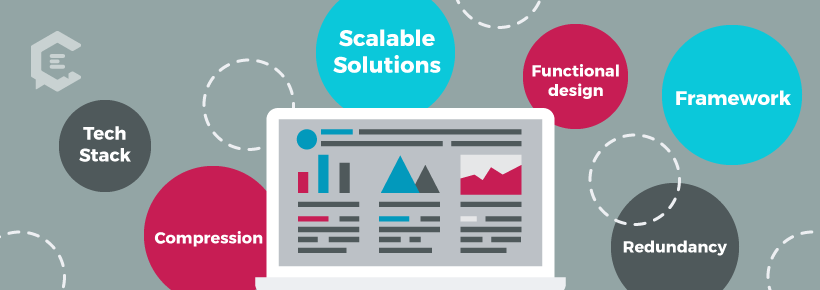Have you ever felt as if you’re trapped in Engineering on the Starship Enterprise? You’re surrounded by levers and buttons and mechanical devices, and you have no idea where anything is or what it does.
As a marketer, you probably feel this way whenever you’re talking to one of your company’s product engineers or software engineers.
There’s just so much jargon, so many little terms and phrases that sound vaguely familiar (like “stack” or “compression”) — but you’re not sure how they apply to the product and to the marketing content you need to produce.
Most marketers are writers on some level, generating carefully worded content that’s designed to resonate with a target audience. In order to be a marketer in today’s digital world, you must also be a tech writer, or at least a writer capable of learning, grasping, and implementing tech-related terms.
To get you there, let’s start with a quick acronym bootcamp for non-engineers.
Over the last ten years of my marketing technology career, I’ve worked with dozens of product and software engineers… and I’ve been compiling mental notes of some of the terms I’ve had to learn. And now I’m going to share them with you.
Depending on your industry, company size and sophistication, you may not come across all these terms. That said, this acronym bootcamp should help you gain a general understanding of some phrases that software and product engineers use every day.
First, let’s review the acronym-free terms you should know regardless…
1. Tech stack (or just “stack”)
A tech stack, or stack, is basically a collection of software tools used to accomplish a desired result. It may refer to all the frameworks, software products, and languages involved in creating the support system for product development and engineering.
2. Scalable solutions
Scalability references how well a particular system can handle growth — how effectively it can support an increase in the amount of work it’s required to do. A scalable solution works well at current levels, but can also be expanded to handle more work or greater production levels as needed.
3. Compression
This term often refers to data compression, a process that reduces the digital information stream in order to save digital space. Basically, you’re making the file smaller so it’s easier to transfer or store.
4. Redundancy
Redundancy has to do with backups. Basically, this engineering process involves creating duplicates of vital components or functions. If one fails, the other can take over. Sometimes, redundancy is more than just a fail-safe; it’s actually a way of chaining components together to create something more efficient or powerful.
5. Framework
Imagine that you want to create an app or a piece of software. A framework gives you the basic tools you need to do it. It takes care of the essentials so you can get down to the business of creating and customizing your app without having to construct every tiny piece of underlying code.
6. Functional design
Functional design ensures that each section, or module, of a device or program can perform its own task to perfection. The term “functional design” can also refer to the big picture — what a product or program does — whereas technical design refers to how a product or program works.
7. Dependency
When one piece of software relies on another in order to work properly, that’s called dependency. It’s an engineering term that typically relates to program modules. If A can’t work without B, then B is A’s dependency.
And now for the acronym soup engineers sup on…
1. CX / UX
These acronyms look cryptic, but they really just stand for customer experience and user experience respectively. Customer experience (CX) encompasses every encounter an individual has with your company, brand, and products. The user experience (UX) refers to how they experience and interface with a specific product, service, or website.
2. PPI
You probably know this one — it stands for pixels per inch. You’ll hear graphic designers mention this term, and you might hear it from engineers designing devices like smartphones, tablets, or anything with a screen. PPI refers to how detailed or clear the image will look on the device.
3. HTML & HTML5
Ok, an easy one. HTML stands for hypertext markup language. Web developers often reference this language, as it’s a foundational element for constructing a website. If there’s a number added on, as in HTML5, that number refers to the version of the programming language, though most developers will only ever reference HTML and HTML 5. Weird, huh!?
4. OOD / OOM / OOP / OOAD
OOD stands for object-oriented design; you may also encounter terms like object-oriented modeling (OOM), object-oriented programming (OOP), or object-oriented analysis and design (OOAD). This is a type of software design approach; basically, it’s the creation of a collection of interactive objects that yield a desired result. It’s a plan or model that software engineers create in order to have a program that flows smoothly and solves the problem at hand.
If you want to really impress your company’s developers, be sure to build any marketing automation (or equally sophisticated campaigns) in a modular, OOD manner, and then be sure to tell them you’re doing it. Talk about it over lunch. Stop by their desk to tell them how cool it is. Get a T-shirt emblazoned with some fun phrases about OOD.
5. MRD / PRD
An MRD is a marketing requirements document. You’re probably familiar with these; they help to establish the value and selling points of a product from a customer’s point of view. A product requirements document (PRD) is similar to an MRD, but it operates from the perspective of the production/engineering team, rather than the perspective of marketing or the consumer base.
6. PRS
PRS stands for product requirement specification. It’s a document that’s usually developed from a PRD, and it can get very technical. In a document like this, you’ll see lots of details about the product’s composition and how variations of those specifications can result in different functionality or features.
7. Pre-EVT / EVT / DVT / PVT
Pre-EVT typically refers to the first official build of a physical product — a prototype. The next phase is the full EVT, or engineering validation test, which still involves a lot of corrections and tweaking.
In the DVT, or development verification test, the team corrects any last-minute bugs related to the product’s functionality. The PVT, or production verification test, permits engineers to work out any kinks in the production system before full-blown mass production begins.
If your company focuses mostly on software products, rather than physical ones, you’ll hear terms like alpha testing and beta testing instead.
8. PCB / PCBA
If you work in a hardware company, these are a definite to add to your vocabulary. A PCB is a printed circuit board; it’s a small green device that shows up in most types of electronics. You may also hear the term PCBA, or printed circuit board assembly, which includes additional components beyond the basic board.
9. CAD
This acronym refers to computer aided design. With special software, engineers can accomplish designs of greater depth and complexity in much less time than if they attempted it by hand.
10. ECP
An ECP is an engineering change proposal. An ECP might be created if the engineering team wants to add a new feature or alter the construction of the product from the initial plan for any reason.
11. QA / QC
As a marketer, QA and QC should be very important to you, because they relate to the quality of the item you’re trying to pitch to your target audience. QA stands for quality assurance, and QC refers to quality control. Quality control happens at the factory or production facility, and ensures that the finished product is defect-free. Quality assurance involves checking the reliability of the product or completing electrical validation.
12. SDK
SDK stands for software development kit. Your company’s software engineers have to obtain the kit for the particular platform for which they are making an app. For example, to create an app that works on iOS, the Apple operating system, you need the iOS SDK.
13. RWD
RWD refers to responsive web design. It’s the kind of design that enables a website to look great on any device, no matter its size or type. If your company website looks amazing on your desktop computer, your laptop, your tablet, and your smartphone, your company is using responsive web design.
Company-specific terms
As you create marketing content for your company, your team may come across some or all of these terms.
However, you’ll also encounter phrases that are specific to your company’s area of technology and engineering. If you don’t understand words that your product development team and software engineers are tossing around like candy, just ask! Chances are, they’ll be glad to tell you what they’re talking about— and when they give you the information, write it down so you won’t need to ask again.
The value of the marketer’s voice
As technology rapidly changes the media landscape, marketers and tech writers not only have to be adept at assessing and adopting the best new applications, but also well-versed in the technical language of this ever-changing digital world. The top marketers and tech writers offer versatility and professionalism, blended with a unique ability to consume new information, process it, and deliver the desired content.
According to a ClearVoice study, the best tech writers command the highest pay rates; but they also yield the greatest ROI for their employers. To be successful in your field of marketing, stay current with the tech terms. If in doubt, ask; and if you can’t ask — well, you can always Google it.





